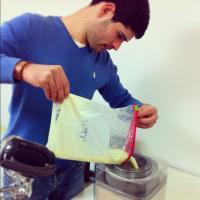-
Posts
55 -
Joined
-
Last visited
Recent Profile Visitors
2,244 profile views
-
Hello fellow ice cream enthusiasts! After 3 loooooong weeks of testing, I've finally posted a new recipe for coffee ice cream: http://icecreamscience.com/coffee-ice-cream-recipe/ I hope it helps! All the best, Ruben
-
Hi Paul! I use the IKA CMAG HS7 magnet stirring hot plate, which is very good, albeit expensive - http://www.amazon.com/IKA-3581201-Magnetic-Stirrer-Ceramics/dp/B00N52H6K2/ref=sr_1_1?ie=UTF8&qid=1451345649&sr=8-1&keywords=ika+hot+plate. There are some cheap used ones on e-bay that might be worth looking into. The stirring bar does occasionally skip when making small batches so I do have to hang whilst the HS7 does its thing. Happy to answer any questions. All the best, Ruben
-
Hmm, interesting. Low overrun, or the amount of air incorporated into the ice cream, also contributes to fast meltdown. Which machine are you using and how long does it take you to churn a batch? You could try leaving your ice cream churning in your machine for another 5 minutes or so to increase overrun. You could also try increasing the egg yolks in the recipe to about 81g. Let me know how you get on.
-
Fast meltdown is usually a sign of lack of emulsifiers in the mix. Have you reduced the amount of egg yolk in your mix?
-
Oops. I knew I had you to thank for the stirring hot plate introduction Jo. The new 25 minute heating method does produce excellent texture but it is not quite as smooth as that produced by the longer heating time. I've introduced it purely to make my recipes more accessible to the home cook. I've also had to increase the fat content in the new method, which gives a slightly heavier ice cream and masks the flavour just a tad. Interesting to see that you use a higher fat content than I do. Let me know if you would like me to send through a copy of the spreadsheet I use to calculate my mixes.
-
Ah, I see. I wasn't sure whether you ended up going with the 25 minute method for the salted caramel. Interesting that the recipe took an hour to make. How long does the reduction process take in your 9" wok? I would recommend that you keep your mix at around 72°C for at least 25 minutes, even if you reach the desired reduction weight before then. The aim of the heating process is two-fold: 1. is to concentrate the mix, thereby increasing the non-fat-milk-solids, primarily the protein, which significantly contributes to smooth texture, and 2. to promote reversible protein unfolding, which, again, significantly contributes to smooth texture. If you don't heat for at least 25 minutes, you are unlikely to get the same rate of reversible protein unfolding and I'm certain that the texture won't be as smooth and creamy.
-
Hi Jim! Good to hear the salted caramel turned out well after some slight tinkering. I've heard of Toscanini's burnt caramel flavour but just can't imagine it being all that nice. I'll have to give it a go the next time I'm over the other side of the pond. Have you tried the new 25 minute heating recipes on the blog Jim? Jo and Jim, have you looked into using a magnetic stirring hot plate to heat and stir your mixes? I think we already spoke about this Jo if my memory serves me well. There are some used hot plates on e-bay by IKA that are good. Merry Christmas to all. Ruben
-
No problem. The pressure is on for the recipe to deliver! Do let me know if you need a hand with anything. Merry Christmas to you, Ruben
-
Hi there Jim! There is indeed a recipe for salted caramel ice cream on the blog http://icecreamscience.com/homemade-salted-caramel-ice-cream-recipe/ I haven't had time to install a 'next page' button on my recipes page so you can't see all of the recipes yet. I'll be updating the blog over the next couple of months. I'd recommend using the recipe and quantities from my vanilla bean ice cream recipe but follow the instructions on the salted caramel recipe for the caramel part. I hope that helps. Let me know if you have any questions. All the best, Ruben
-
Ruben Porto changed their profile photo
-
A good evening to you Vasco! I have indeed tried the around 72°C heating method and I for one think it's a marvellous way to make ice cream! It takes a bit more time and effort but the results are certainly worth it. Feel free to send any questions my way.
-
Hi Jim! I want to thank you for bringing a smile to this somewhat hideous face of mine. Your comments and feedback make the long nights writing up the recipes worth while. Your feedback has been noted and I will edit the recipe when I get time to reflect the number of lemons needed. Thank you for motivating me to keep going. All the best, Ruben
-
Hi guys, I've posted a recipe for stem ginger ice cream on my blog and would love some feedback if anyone gives it a try. http://icecreamscience.com/stem-ginger-ice-cream-recipe/ Cheers in advance, Ruben
-
Hi Paul, I think you are very likely to develop the cooked milk flavour, as well as the eggy hydrogen sulphide flavour, if you heat your mix to 79°C and hold it there for 2 hours. I found that my mix developed a cooked milk flavour when I heated it to around 73°C for 60 minutes. I wouldn't recommend going above about 72°C. The sugar and total solids contents do indeed push up the temperature at which milk protein undergoes reversible unfolding. I haven't been able to measure the amount of irreversible denaturation that takes place but would love any information on this if you come across any. All the best, Ruben
-
Hi Paul! Interesting to see you using sous vide to prepare your mix. I've been thinking about playing around with sous vide for a while now but simply haven't had the time to give it a go. I agree that keeping the temperature at 72°C prevents the cooked milk and the eggy hydrogen sulphide flavours from developing. I wouldn't recommend heating your mix to 85°C or 90°C for a prolonged period of time as this is highly likely to lead to irreversible protein denaturation, which is detrimental to texture. If you're using egg yolks, depending on the quantity you use, you are also likely to develop the hydrogen sulphide note in your ice cream. I would certainly recommend heating your mix for longer than 40 minutes as I have found better emulsification and foaming properties in the milk proteins with longer heating times. I would also suggest increasing your total solids count if you are experiencing icy texture. I hope that helps. Let me know if you have any questions. All the best, Ruben
-
Hi Luke, The chocolate recipe is now on my to-do list to say thank you for your feedback If you can't wait, try using the recipe for lemon curd and just substitute the chocolate ingredients for the lemon curd. That should work. Please do let me know how it turns out if you give it a go.








